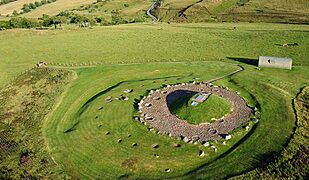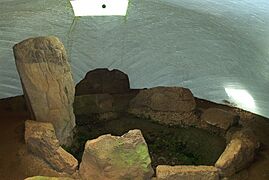Cairnpapple Hill facts for kids
Quick facts for kids Cairnpapple Hill |
|
|---|---|

Burial mound on Cairnpapple Hill
|
|
| Highest point | |
| Elevation | 312 m (1,024 ft) |
| Prominence | c. 173 metres (568 ft) |
| Geography | |
|
Lua error in Module:Location_map at line 420: attempt to index field 'wikibase' (a nil value).Lua error in Module:Location_map at line 420: attempt to index field 'wikibase' (a nil value).
|
|
| Location | West Lothian, Scotland |
| OS grid | NS987718 |
| Topo map | OS Landranger 65 |
Cairnpapple Hill is a special hill in central Scotland. From its top, you can see all the way from one coast to the other! For about 4,000 years, people used this hill for important ceremonies. It was once as famous as places like the Standing Stones of Stenness.
The top of the hill is 312 meters (about 1,024 feet) above sea level. It is located about 3 kilometers (2 miles) north of Bathgate. In the 1800s, trees completely covered the site. But in 1947 and 1948, an archaeologist named Stuart Piggott dug there. He found many ancient monuments from different times in history. Later, in 1998, Gordon Barclay helped us understand the site even better for Historic Scotland. Today, Cairnpapple Hill is a protected ancient monument.
Contents
A Journey Through Time: Cairnpapple's History
Cairnpapple Hill has a long and fascinating history. People used it for special events for thousands of years. Archaeologists have found clues about these ancient rituals.
Stone Age Ceremonies (around 3500 BC)
The first ceremonies on Cairnpapple Hill happened around 3500 BC. This was during the Neolithic period, also known as the New Stone Age. People lit small fires, called hearths, on the hill. They also left valuable items as gifts. These gifts included beautiful pottery bowls and stone axe heads. Some of these axe heads came from far away places like Cumbria and Wales.
The Henge Monument (around 3000 BC)
Around 3000 BC, people built a large circular monument called a henge. They dug a ditch about 3.6 meters (12 feet) wide into the rock. This ditch surrounded the hilltop. Outside the ditch, they built a bank of earth. There were wide entrances on the north and south sides.
Inside this henge, there was an egg-shaped circle of 24 tall posts. These were probably made of wood, but some might have been standing stones. Inside this outer circle, there was another smaller circle of similar posts.
Bronze Age Burials and Cairns (around 2000 BC)
Later, during the Bronze Age, new rituals took place. People built a small stone and clay cairn (a pile of stones) inside the henge. Next to it, they placed a tall standing stone, about 2.1 meters (7 feet) high. There was also a circle of smaller stones.
Near this cairn, archaeologists found holes for three more upright stones. These were at the center of an arc of seven small pits. Six of these pits held cremations (burned bones). Two pits also had bone pins. Under the small cairn, there were signs of at least one burial. It included wooden objects, perhaps a mask and a club. Pottery from the Beaker culture was also found, showing this was around 2000 BC.
This small cairn was later covered by a much bigger one. This second cairn was about 15 meters (50 feet) across and several meters high. It had a border of huge stone slabs. Inside this larger cairn, there were cists, which are stone boxes for burials. One cist held a special pot called a "food vessel."
Even more stones were added later, making the cairn about 30 meters (100 feet) wide. This huge cairn covered the original ditch and bank. It became a massive tomb monument. Inside, there were two more cremations in upside-down pots.
Later Graves (around 500 to 1000 AD)
Finally, four graves were found inside the ditch on the east side. These graves are thought to be from early Christian times, around 500 to 1000 AD. Their east-west direction is typical of Christian burials.
Visiting Cairnpapple Hill Today
Cairnpapple Hill is open to visitors from April to September. There is a small visitor centre where you can learn more.
The archaeologists have covered part of the 1940s dig site with a concrete dome. This dome looks like the second, larger cairn, but it's much taller. You can go inside the dome to see reconstructed graves. Outside, the places where posts and graves were found are marked with colorful gravel. Red gravel shows where upright posts stood. White gravel marks the early Christian burials. This display helps you see all the different historical periods at once.
Cairnpapple Hill is also known as the 445th highest "Marilyn" in Scotland. A Marilyn is a type of hill with a certain height and steepness. The very top of the hill is actually a bit south of the main monument, near a trig point (a marker used for surveying).
What Does "Cairnpapple" Mean?
The name "Cairnpapple Hill" is a bit of a mystery! People are not entirely sure where it comes from. It might be from an old language called Brythonic, which is related to Welsh. Or it could be from a Goidelic language, like Scottish Gaelic. It might even be a mix of both.
The first part, "cairn-", definitely means a cairn (a pile of stones). This word is similar in both Welsh (carn) and Gaelic (càrn). The middle part, "-ie-", probably means "of the." This is like "y" in Welsh or "a" in Gaelic.
The last part, "-papple," is the trickiest. It could mean "tent" (Welsh pabell, Gaelic puball). It might also mean "people" or "congregation" (Welsh pob(o)l, Gaelic pobull). Some even think it could mean "eye" (from Old Welsh pubell). So, "Cairnpapple" most likely means "Cairn of the tent," "Cairn of the people," or "Cairn of the eye."
Gallery



